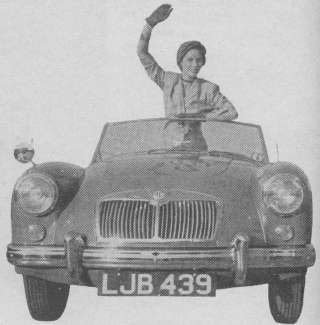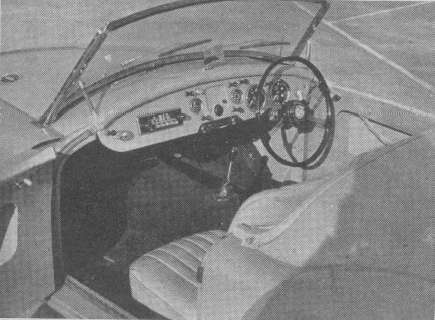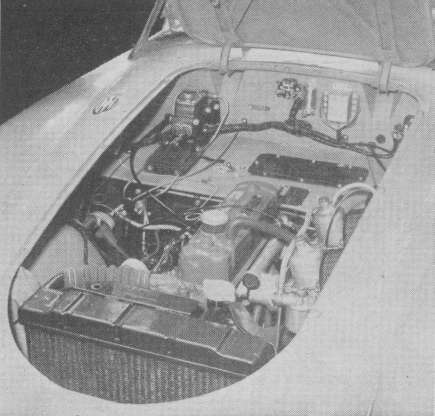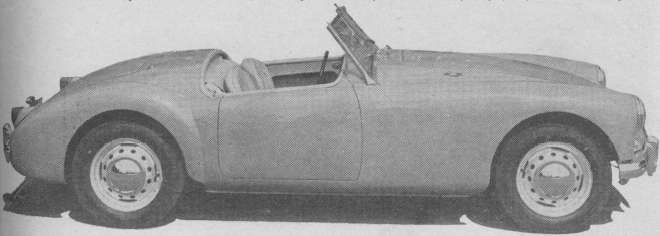The MGA With An Attitude
| MGAguru.com |
|
MGAguru.com |
Wheels takes you driving in the new M.G - LT-104
|
From Wheels magazine, December 1955
Wheels
takes you
driving
in the
new M.G.
By Gordon Wilkins, our European Correspondent.
|

|
Better Handling, better comfort, better wind protection, better speed -- that's how the new M.G.A.-type stacks up against the old TF.

There's much more room in the new A-type. Notice the new wheel, the instruments, the screen. There is an arm-rest between the seats.
|
|
interior width is up to 48 in. across the seats, although external width overall is an inch less than on the TF.
 There's more space for elbows and feet. There's more space for elbows and feet.
 The four-spoke flexible wheel is new, and the instruments are now in circular dials (no more octagons) grouped in front of the driver. There is a 110 mph speedometer, a rev counter with a yellow segment starting at 5,500 r.p.m. and a red sector at 6,000 r.p.m., oil pressure gauge, water thermometer, and, at last, a fuel gauge. In front of the passenger is a hooded lamp for the reading of maps and route cards. The four-spoke flexible wheel is new, and the instruments are now in circular dials (no more octagons) grouped in front of the driver. There is a 110 mph speedometer, a rev counter with a yellow segment starting at 5,500 r.p.m. and a red sector at 6,000 r.p.m., oil pressure gauge, water thermometer, and, at last, a fuel gauge. In front of the passenger is a hooded lamp for the reading of maps and route cards.
 The view is unbstructed ahead across both front wings and the sloping bonnet. The detachable curved screen has small supporting struts at the corners shaped to form hand grips and excellent protection is given by the easily erected hood. This has a leather-like finish. The view is unbstructed ahead across both front wings and the sloping bonnet. The detachable curved screen has small supporting struts at the corners shaped to form hand grips and excellent protection is given by the easily erected hood. This has a leather-like finish.
 There are rigid side screens, with spring loaded flaps for signalling. There are rigid side screens, with spring loaded flaps for signalling.
 There is a reasonable large luggage space in the boot, above the spare wheel jack and tool kit; enough for two suitcases and some smaller packages. Maps and small packagees can go in big recesses in the doors. There is a reasonable large luggage space in the boot, above the spare wheel jack and tool kit; enough for two suitcases and some smaller packages. Maps and small packagees can go in big recesses in the doors.
 It's a nimble car, this new M.G., with light, quick steering and a 28 ft. turning circle. Gear ratios are more widely spaced than on the TF, so there is not much difference in maximum speeds on first and second gear, but it takes a road speed of 70 or so in third to put the rev counter needle in the red, It's a nimble car, this new M.G., with light, quick steering and a 28 ft. turning circle. Gear ratios are more widely spaced than on the TF, so there is not much difference in maximum speeds on first and second gear, but it takes a road speed of 70 or so in third to put the rev counter needle in the red,
|

and on top, the car runs happily up to over 90 quite quickly
 From the performance of the Le Mans prototypes, when fitted with production-type windscreens, it looks as if the maximum of the standard model with 68 b.h.p. engine will be about 95 m.p.h. From the performance of the Le Mans prototypes, when fitted with production-type windscreens, it looks as if the maximum of the standard model with 68 b.h.p. engine will be about 95 m.p.h.
 The gear shift is good, via a short stiff central lever, but on right-hand-drive cars reverse calls for an out and back movement, somewhat less convenient to perform quickly in rally tests than the inward pull required when the steering wheel is on the left. The hand brake lever is still the fly-off racing type, but smaller and a little less convenient than the lever on the TF. The gear shift is good, via a short stiff central lever, but on right-hand-drive cars reverse calls for an out and back movement, somewhat less convenient to perform quickly in rally tests than the inward pull required when the steering wheel is on the left. The hand brake lever is still the fly-off racing type, but smaller and a little less convenient than the lever on the TF.
 The reduction in engine revs permitted by the 4.3 to 1 axle ratio and 5.60 inch tyres on 15 inch rims means pleasant cruising at 70 with much less sensation of mechanical effort. The reduction in engine revs permitted by the 4.3 to 1 axle ratio and 5.60 inch tyres on 15 inch rims means pleasant cruising at 70 with much less sensation of mechanical effort.
 Handling and roadability constitute a big step forward. Theoversteer I seem to have noticed inteh old car have gone, and teh back end is slower to break away. Roll is negligable, and the brakes, the same size as used at Le Mans, gave me a lot of confidence. Accelleration from 0 to 50 m.p.h. takes about 12 secs. and unofficial tests with an MGA at steady speeds have shown 38 miles per Imp. gallon, at 50 m.p.h. Handling and roadability constitute a big step forward. Theoversteer I seem to have noticed inteh old car have gone, and teh back end is slower to break away. Roll is negligable, and the brakes, the same size as used at Le Mans, gave me a lot of confidence. Accelleration from 0 to 50 m.p.h. takes about 12 secs. and unofficial tests with an MGA at steady speeds have shown 38 miles per Imp. gallon, at 50 m.p.h.
 There is less wind buffeting and draughts in the new car; additionally one can have a heater with adjustable blower. So far, no tuning stages have been announced for the B-type engine. Presumably the most advanced stage might incorporate the Weslake cross flow cylinder head, with four carburetors; two on the hot side for part throttle running, and two more on the cold side to be brought in for full power. There is less wind buffeting and draughts in the new car; additionally one can have a heater with adjustable blower. So far, no tuning stages have been announced for the B-type engine. Presumably the most advanced stage might incorporate the Weslake cross flow cylinder head, with four carburetors; two on the hot side for part throttle running, and two more on the cold side to be brought in for full power.
 However, no such equipment is available at present, but immediate competition requirements are met by sodium filled exhaust valves with overbored valve guides, racing clutch, racing wire wheels with light alloy rims, a 24 gallon fuel tank, racing bonnet straps, and a full choice of several axle ratios. However, no such equipment is available at present, but immediate competition requirements are met by sodium filled exhaust valves with overbored valve guides, racing clutch, racing wire wheels with light alloy rims, a 24 gallon fuel tank, racing bonnet straps, and a full choice of several axle ratios.
 Other extras on the list are radio, screen washer, adjustable telescopic steering column, 5.90 section road speed tyres, radiator blind, external mirror and cockpit cover. Other extras on the list are radio, screen washer, adjustable telescopic steering column, 5.90 section road speed tyres, radiator blind, external mirror and cockpit cover.
|
|

For high-speed touring the standard twin carburetors (above) could quite easily be supplanted by two more on the other side of the Weslake cross flow cylinder head. This photograph by "The Motor" in England.
SPECIFICATION
ENGINE
4-cylinder, pushrod o.h.v., 73.425 x 80 mm (2.875 x 3.5 in), 1489 cc (90.88 cu.in.) 8.15 to 1. Max power 68 b.h.p. at 5,500 r.p.m. Max torque 77.4 lb.ft. at 3,500 r.p.m. Two inclined S.U. carburetors.
TRANSMISSION
Single plate dry clutch, 8 in; hydraulically operated 4-speed gearbox with central lever. Syncromesh on second, third and top. Open propellor shaft, hypoid bevel rear axle. Overall gear ratios 4.3, 5,908, 9,520, 15.652 TO 1. Reverse 20.488 to 1. 17 mph per 1,000 rpm on top gear.
SUSPENSION AND STEERING
I.F.S. by coil and wishbone. Half-elliptic springs at rear. Opposed piston hydraulic dampers. Rack and pinion steering.
|
|
BRAKES
Hydraulic, 21-s.* at front. Drums 10 in x 1-3/4 in. Total friction lining area 134.4 sq. in. Fly off racing type hand brake.
WHEELS AND TYRES
Bolt-on perforated disc wheels with 5.60-15 in. tyres. Centre lock wire wheels optional at extra cost.
ELECTRICAL SYSTEM
12 volts constant voltage generator control. Coil ignition with centrifugal and vacuum spark control.
DIMENSIONS
Wheelbase 94 in. Track 47-1/2 (front 48-1/4 in. (rear). Overall length 156 in. Width 58 in. Height 50 in. Curb weight 1990 lb. Fuel tank capacity, 10 imp. gallons. Ground clearance 6 in.
|
|


Smooth, speed-giving lines are handsome as well. The wheels can be discs or
wires, according to customer preference. This photograph by "The Motor", in England.
|
WHEELS, December, 1955
|
|
|